- 5 Simple Tricks to Eliminate Maggots From Pet Waste - October 24, 2023
- Keep Your Outdoor Compost Piles Maggot-Free - October 24, 2023
- How to Get Rid of Maggots – Methods that Work - August 30, 2023
Slugs and snails are simply not the small living organisms to have around your garden. As a gardener or a small-scale farmer, you might have seen and concluded this also. If you already haven’t had to wake up to a tsunami of slime-balls; oh well its a sigh of relief for you. However, it is important to be readily equipped just in case the slimy army decides to visit and stay around your home and yard. To bring you to a better understanding of how exactly these harmless-looking creatures turn out to be a complete nightmare, let us do a small background check on these garden destroyers and how to get rid of garden slugs and snails.
Some basic slimy facts
Slugs and snails are gastropods and members of the mollusc species. Gastropods means stomach foot; they obviously slide/move by their stomachs. They both have shells just like every other member of the mollusc species. It is hard to believe that slugs actually do have shells. But the truth is they do have a shell; only that the slug’s shell is very small and is hidden inside the slug.
Slugs and snails come in different colors and shell patterns; they all do not look the same. There are actually shell patterns that are quite artistic. And there are relatively good-looking slugs; the red ones. Though I must point out, a slug is a slug. So, why not entertain them around your backyard? Both are destructive. Snails will eat around the edges of leaves or eat whole baby leaves.
And what’s a plant without its food factory? The snails have razor-like tongues that facilitate the sawing of the leaf edges. Slugs, on the other hand, bore holes in leaves or eat small ones whole and bore into tender roots. Not nice at all. Hence, it is crucial to get rid of both slugs and snails before they cause many problems.
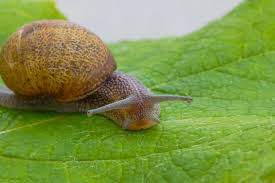
There are a couple of ways to get rid of the slugs and snails permanently. Some of the ways are relatively humane. In that, they do little or no harm to them. The humane/organic ways will mean no harm or remove useful organisms in your garden. However, if the humane ways are not applicable to your case, it is okay to eliminate them in other ways. Below are ways on getting rid of slugs and snails permanently.
1) Scooping them out
This is simply a way to get them off your garden and move them to a new habitat where they are not pests. Scooping can be done using a small hand shovel. Do not use your hands to pick them up. It is not pleasant to have their slime all over your hands. If you decide to go this way, however, use vinegar and warm water to wash off the slime. Once you have scooped them, put them in a small bucket to get rid of the slugs.
Dump the slugs and snails in a compost heap or under some wild shrubs or take them to a park. In these new environments, they will not come back. however, be wise and dump them in places not so near your house. The best times to collect them is dusk or early morning as they are often out feeding at night. Also when it’s damp or while it is raining is a good time to get rid of slugs.
2)Setting up barriers
You can set up a relatively small barrier that is not a pleasant environment for the snails and slugs and it will keep them away from your growing plants. There are different materials that can be used for the barriers to minimise slug damage.
1. Copper tape
Copper tape reacts with the snail/slug slime and causes a small electric shock. The snails and slugs will surely avoid the copper barrier knowing the effects of it. This will clear out all the visiting pests. They surely will not come back. Use the copper around your garden. Ensure you keep changing or cleaning the copper once each week. Copper loses its effectiveness out quickly, but it can be washed using vinegar. This may not get rid of slugs and snails for good, but it can stop them getting near your plants.
2. Dry eggshells
Eggshells or nut shells- these are dry and rough. Slugs and snails survive only in damp conditions. Hence a dry barrier is going to be uncomfortable for them. Ensure the shells are dry before placing them out there. The shells are also rough, hence they may cut the slug or snail. This is another way to surely remove them. The uncomfortable conditions will make them move. Sand and sawdust are also good barriers. They look ugly to the snail or slug. Also, they are dry, not a favorite to any snail or slug.
The barrier method simply makes the environment not favorable to the snails and slugs hence they naturally move to a more conducive environment for them, therefore it is a good way to get rid of slugs and for snails too.
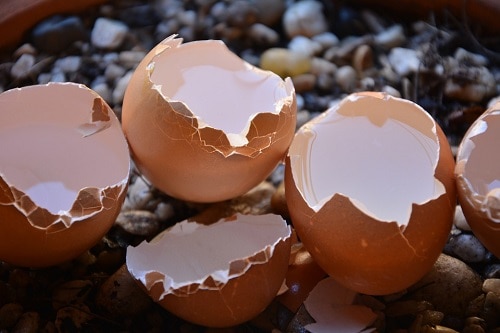
3. Diatomaceous earth
Diatomaceous earth can be an effective way to keep slugs away from an area of your garden. The earth is rough against the bodies of slugs and snails and they will avoid trying to cross it. To use it to get rid of slugs or snails, just sprinkle some on the ground around the areas you want to protect.
3) Using domesticated birds
Birds love eating slugs and snails. Hence they are a favorite way to deal with them. Domesticated birds are best to use just before planting. After planting the birds will unearth the seeds or trample on the growing seedlings or peck on the young leaves. This way the domestic birds will have served their purpose but done more harm.
Therefore, release the domestic birds into the slug filled area in your yard only before planting. Let the birds enjoy their feast and get rid of the snails and slugs permanently. Domesticated birds could include chicken and ducks. Be sure to release them early in the morning before the snails and slugs go into hiding. Birds can easily get rid of slugs for you, but it is a bit harder to them to eradicate the snails, due to their hard shells. You will sometimes see birds dropping snails from a height, in order to crack their shells.
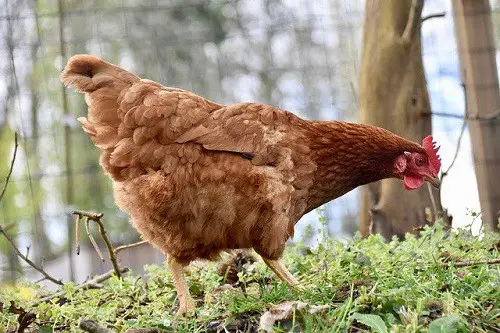
4) Plants they like that can draw them away
There are plants that snails and slugs do love. Having them in strategic places will help eliminate them from your garden. You simply lure them away with a promise of better food for them. The plants are not harmful in any way. Actually, most are an added advantage. They add nutrients to the soil. The sacrificial plants are leafy hence will keep the snails and slugs away permanently. Examples of sacrificial plants suitable for them include lettuce and red clover.
5) Using salt/ammonia
This is the most traditional means around. It has been in use for many years for the snail and slug control. Can be done by sprinkling salt over collected pests. Point to note here: the slugs and snails have to be collected first. Do not pour salt into your garden. If poured on your backyard, it will increase the soil salinity, decrease its pH hence making it acidic.
This is hazardous to the plants in your yard and they may end up dead too. Therefore collect your snails and slugs first, then destroy them with salt outside the area. The crystals bind moisture hence is deadly to them. For use within the garden, use double-sided tapes or a broken gutter. Sprinkle some on the double-sided tape. Pour it on the broken gutter and place the broken gutter on the ground as a barrier to the snails and to get rid of slugs.
Just in case the salt pours on the soil while watering or when it rains, use garden lime to counter the salinization. The lime will bring back the pH to neutral. This is a slow but sure way to kill all the snails and slugs.

6) Using caffeine or coffee grounds as a deterrent
Studies have shown that high concentrations of caffeine sprayed on slugs and snails will kill them. Low concentrations will make the slugs and snails leave the garden and stop feeding on it. Spraying plants with caffeine also prevent them from eating them. There are caffeine based commercial sprays available that you can buy.
These have high concentrations of caffeine hence will kill the snails and slugs instantly. You may use a solution of alertness or stimulant capsules that contain caffeine. Simply spray the solution on the garden soil to get rid of slugs and snails. You may also use used coffee grounds. The used grounds are poured and spread on the soil. Used grounds can be purchased in coffee shops. The caffeine is also beneficial, as it is organic matter and in turn fertilizes the ground.
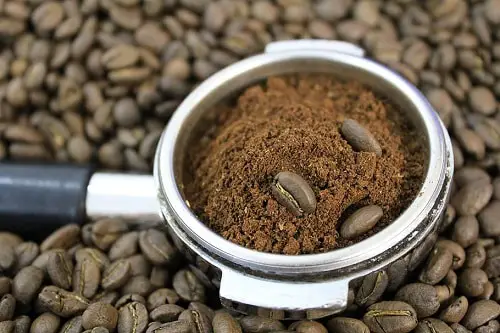
7) Repellent plants
Slugs and snails love plants with tender and succulent leaves. They also love leaves with no scent at all. Therefore, intercropping with woody plants will get rid of the slimy creatures for good. They do not like eating anything leathery, stiff or aromatic. Therefore, the following plants will be a nightmare to the snails and their slug cousins: Peruvian Lily, carnations, foxglove, coneflower, cushion spurge, bananas, ferns, daylily.
Most of these slug and snail resistant plants are grasses and ferns. They are easy to grow and do not eat up the other garden plants. You help this plants to eradicate the snails and slugs by basically changing their meal. The snails and slugs will notice that they are not welcome anymore at the garden and will certainly leave. The grasses and ferns actually do entertain other beneficial insects that improve the air circulation in the soil. Hence will serve two purposes at a time and keep slugs away..
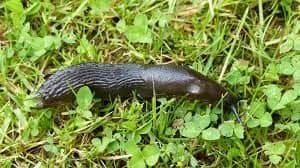
8) Attracting predators
Snails and slugs just like every other living organism on the food chain have predators. The only reason the snails and slugs thrive so well in your garden is due to lack of enough natural predators to feed on the slugs and snails. They have a couple of enemies/natural predators. They include ground beetles, pathogens, toads, snakes, turtles, birds, nematodes, hedgehogs, moles, lizards, and songbirds. Nematodes are small microscopic worms known to kill them.
Most of these creatures are harmless to your garden. However, the environment in your garden could possibly be not conducive to the natural predators. Hence, it is important to work on ways of attracting them and also providing a suitable habitat for them. Some of the ways to do this include: planting indigenous plants, creating wild corners within your garden, having a pile of stones with cracks somewhere nearby, having a natural hedge, minimizing the lighting around your property if possible and avoiding the use of insecticides and other chemicals that are harmful.
9) Snail and slug traps using pellets and baits
The slug pellets and baits contain low percentages of metaldehyde. Metaldehyde is effective at killing snails and slugs. The metaldehyde works by dehydrating the snails and slugs. It kills the snail or slug instantly. The bait resembles dog food and is flavored with bran or molasses to attract them. The baits are sold off the counter. However, this may not be a safe method if you have pets around the garden. The metaldehyde is toxic to dogs, cats, and birds. Hence use the baits and chemical slug traps only if you have no pets around the garden.
Iron phosphate pellets have been used for many years as a way to get rid of slugs and snails. It is generally no-toxic to humans, but is believed to be and effective method of snails and slug control.
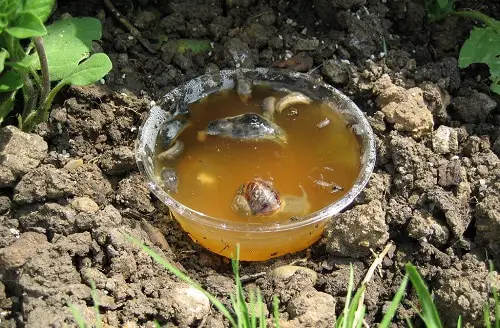
A more natural alternative is to use a beer trap. The idea is that the beer attracts the slugs and snails and once inside, they can’t escape. You ten just scoop them up, move them somewhere else, or dispose of them if they happen to have drowned in the beer. You can buy one, usually made from plastic, or you can make one yourself using a half grapefruit skin and filling with beer.
Conclusion
The above ways will help get rid of snails and slugs permanently. A snail free garden is a highly productive garden. However, avoid ways that will mean harm to your garden in any way. Go for the harmless means first to reduce slug damage. There are molluscicides available in pesticide shops. However, the molluscicides will be harmful to other beneficial insects and creatures around your home. Some molluscicides will even destroy your plants. Make your choice and remove the snails and slugs easily. Be kind on them though. Go for the more natural means of slug control. Relocating them is the kindest you can be in controlling the slug population and snails around your garden.
To return to the home page click here -> DeadPestz
